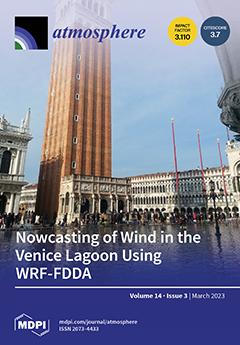To characterize seasonal carbonaceous aerosol pollution in Taiyuan, a typical city in North China that mainly relies heavily on coal, a total of 124 PM
2.5 samples were collected from August 2018 to the next May. The annual mean PM
2.5 concentration was 83.8 ± 48.5 μg m
−3, with a seasonal rank of winter (117.4 ± 47.6 μg m
−3) > spring (79.2 ± 34.3 μg m
−3) > fall (67.3 ± 34.7 μg m
−3) > summer (31.8 ± 6.5 μg m
−3), suggesting that fine particulate pollution was still serious in cold seasons. Organic carbon (OC) and elemental carbon (EC) showed similar seasonal patterns with PM
2.5. The mean concentration values of OC in summer, fall, winter, and spring were 5.1 ± 0.9, 11.8 ± 6.4, 22.1 ± 14.9, and 12.2 ± 6.7 μg m
−3, respectively. The mean concentration values of EC in summer, fall, winter, and spring were 1.5 ± 0.3, 2.5 ± 1.6, 4.4 ± 2.8, and 2.4 ± 1.5 μg m
−3, respectively. The proportion of total carbon aerosol (TCA) was about 31.7%, 33.8%, 30.0%, and 27.0% in PM
2.5 in summer, fall, winter, and spring, respectively. The good correlation between OC vs. EC and the high value of OC/EC suggests that coal and biomass combustion were the main emissions in cold seasons, aggravated by adverse meteorological conditions and the dustpan-shaped terrain. The mean annual secondary organic carbon (SOC) concentration was 6.1 ± 7.1μg m
−3, representing 38.7% of the OC content. The present results presented the serious carbonaceous particulate pollution, which might affect haze pollution in cold seasons.
Full article





